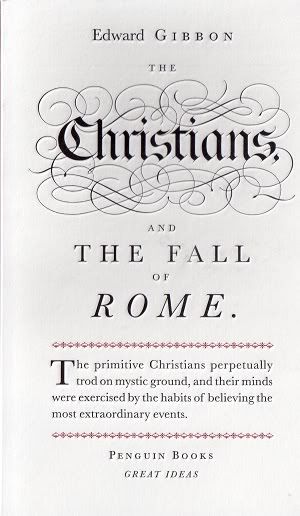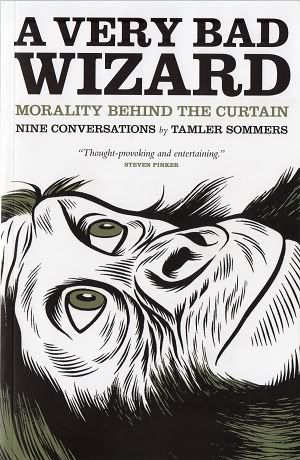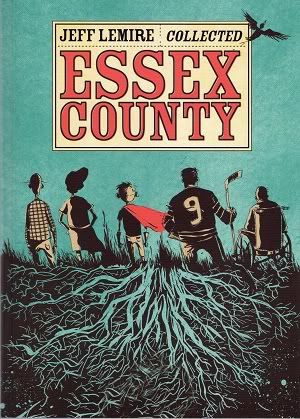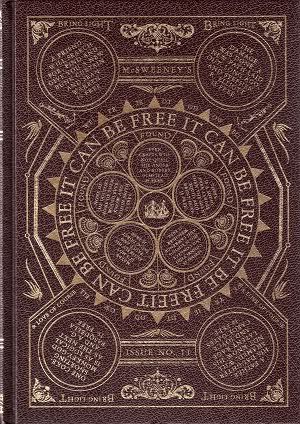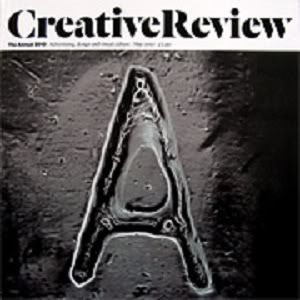Books books books (more accurately, Magazines, Magazines, Comics), this'll be a big one because I apparently have nothing to do with my time but read.
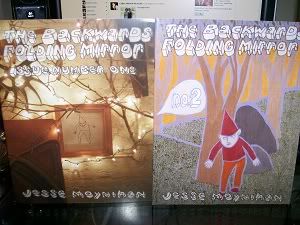
First off are the first two issues of L.A cartoonist Jesse Moynihan's
The Backwards Folding Mirror.
I wasn't sure if I wanted to review these together or separately, but after realizing how much I have to write already, and how close in quality these were, I just tossed them together.
The Backwards Folding Mirror is a story based on the author's troubled relationship with a past girlfriends (hence why there are only two issues, unfortunately for everyone but him), but with ghosts and talking animals thrown in.
It sounds awfully unappealing, I know. But between the excellent drawing and the great punchlines, I had a blast reading (and re-reading) these. A highlight is a joke about the ghost of his girlfriend's father watching over them while they sleep, but that was just one of the many times I laughed out loud at these great comics. Moynihan is currently working on a weekly online strip called
Forming, about an alternate reality creation story, check it out
here.
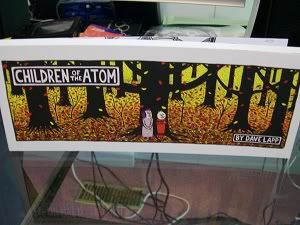
Carrying on with comics, but bringing it a little closer to home is Toronto artist Dave Lapp's book of collected
Children of the Atom strips. I'm unsure of where these originally ran, but I sure am glad they were all collected into a single book. Many reviews I've read compare this strip to Samuel Beckett's plays, and while I don't think that it's totally off the wall, I think they are THE CLOSEST THING to Samuel Beckett that has happened in comics.
Featuring only two characters, each strip places Franklin Boy and Jim-Jam Girl in an often surreal situation while they constantly bicker back and forth, and while it's obvious they have some sort of connection, it's hard to put a finger on. That being said, each strip stands alone as being a self-contained story in five (give or take) panels. While that isn't uncommon, it's amazing how much content Lapp packs into each of them while at the same time being extremely modest with dialogue and generally simply movements.

Stepping out of comics-dom for a moment, here's the 10th installment of Penguin's
Great Ideas series with Thomas Paine's
Common Sense. Cited as being one of the revolutionary sparks that landed on the haystack of colonial America, this was one of the most interesting (and quickly read) volumes of the series that I have read thus far.
Using common sense to persuade the colony of America into a fight for independence from their colonial masters, Paine looks at the redundancy of obeying a king literally half a world away as he points out that England will never come to assist America, while at the same time exploiting America for everything that it's worth. Sound familiar? I thought so. Reading this, one can't curb the urge to look at this in a modern context. Now that America has broken free of its English chains, it has shown no hesitation in condemning other nations to a fate that was once it's own. Sure, "colonialism" is treated as somewhat of a dirty word as of late and as such it's hard to claim that third world countries are really just colonies of the United States of America, but it's only a matter of time until thoughts similar to Paine's show up in places like Mexico.
This should be required reading for everyone, simply because it provides a much needed nudge to think critically of even the most obvious things in government. If it's too good to be true...
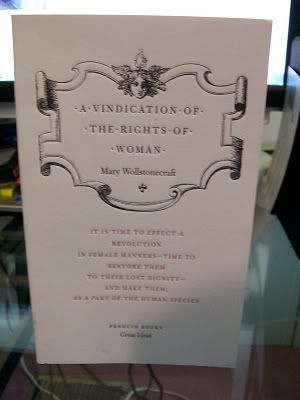
Following Paine's calls to question government, comes Mary Wollstonecraft's calls to question the prejudices that have plagued women from the dawn of society, in the form of
A Vindication of the Rights of Woman, the 11th
Great Ideas book.
I was glad upon reading this book that I was as enthralled with it as I was with Paine's work, after a couple minor let downs in the previous couple of books in this series. One of the first pieces of proto-feminist literature,
A Vindication... laid down the claim that in order for women to mature to the fullest potential of human nature, they should be entitled to the same education as any man, and have the opportunity to pursue enjoyment in activities that were more intellectually stimulating than lives consisting of innocence, sensual exploits and an odd novel here and there.
What I found most interesting in reading this was that there was no open effort to attempt to make men and women equal (as seen by Wollstonecraft's frequent references to men as "the stronger sex"), but rather establishing herself as someone who I would argue set goals realistic at the time (in urging women to educate themselves)and laying down a female-positive intellectual framework. I really could go on about this for much longer, and maybe I will in another post, but I'll end this and say that the urging for intellectual growth is applicable to anyone, of any time period, regardless of gender. And simply viewing this as a piece of "feminist writing" is doing it a disservice.
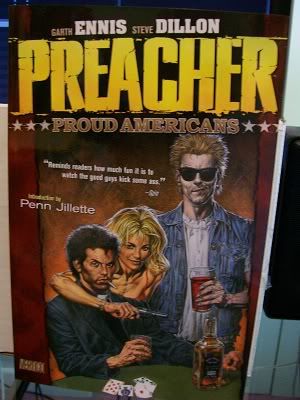
Time for a total reversal of subject and talk about the third volume of Garth Ennis and Steve Dillon's
Preacher. Hailed as one of the most groundbreaking series in mainstream comics, I put off reading this for far too long and I've slowly been chugging through.
There's something about the series that just doesn't click for me, and I can't quite put my finger on it. I love Ennis'
Punisher MAX, and I even enjoyed the first two volumes of
Preacher but this one almost seemed like a struggle to read at times. I think it might be due to the amount of character back story that is revealed in this volume, I felt like I already had my own ideas of history in place for Cassidy and Jesse's dad and that revealing them in a way that conflicted with my own made it less enjoyable.
Qualms out of the way, I plan on continuing through the series, primarily due to the fact that the main story line is beginning to heat up in a big way and I love the subject matter, art and amount of violence in this series. (The end of this volume has a VERY satisfying splat, you'll understand once you read it.)
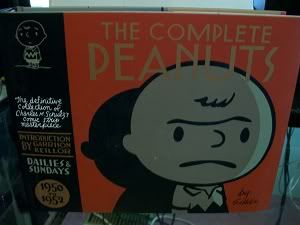
Accidentally blending the world of comic strips and philosophy, I set out on my summer goal to read through as many books of
The Complete Peanuts as I could. Drawn by Charles Schulz (If this is news to you, climb out from your rock.), the first book compiles every strip and Sunday special from 1950-1952.
After casually reading Peanuts strips for as long as I can think back, there is a much different feeling reading them in a chronological format (and so many at once.). The book starts out with a small cast consisting only of Charlie Brown, Snoopy, Patty and Shermy, and slowly begins to grow, eventually involving Violet, Lucy, Schroeder and even a baby Linus towards the end. Watching the characters mature (I.E. Watching as Schulz became comfortable writing them) is probably the greatest part of the book. Containing over 700 strips, there is no shortage of laughs, and while it may not be
Peanuts at it's prime, it's very clear that it is on its way to greatness.
Also included is an essay on Schulz' life by David Michaelis and even more excitingly, a reprinted interview with Schulz done by comic historian Rick Marshall and Fantagraphics Books co-founder Gary Groth. In it Schulz tells of his favorite comics and artists, least favorite comics and artists and also about his life in general, a great read. I look forward to reading more of these great collections by the time school resumes.
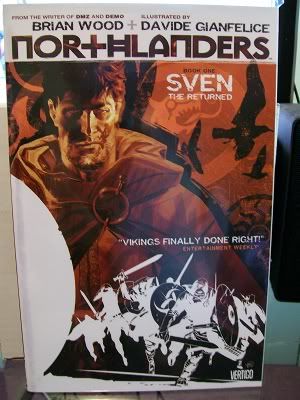
Following up a comic with an artist of Scandinavian descent with a comic about Scandinavians he may have (but hopefully did not) descended from, here's the first volume of Brian Wood and Davide Gianfelice's
Northlanders.
I was itching to check this book out ever since I heard about it through the vast expanses of the internet, and after finally tracking down the first three volumes at a local comic store I jumped at the opportunity.
Totally worth it, beautiful art, great viking-style dialogue (the most eloquent of barbarians), and no shortage of battle axes to heads, arrows to the throat and decapitations. The story is so-so this far, but I'm not expecting anything to special from a series advertised as a crime series based around vikings. They aren't overly clever (save one), so why should the book be? I'll be reading the next two volume ASAP, and considering I made it through this 200 page book in a little under an hour, I feel like that will be an easy yet extremely rewarding task.

Totally unrelated, this is the May 2010 issue (Volume 62 NO.1) of Monthly Review, an "Independent Socialist Magazine".
I had my gripes last go-around with
Relay as being sometimes too academic for its own good. It was good, but it focused far too much on dense economic theory, which is interesting in it's own right but there is no way to make it completely satisfying reading on it's own.
Monthly Review is great to balance that out. With some articles still bringing up the slightly intimidating numbers game (Such as John Foster and Hannah Holleman's
The Financial Power Elite, it's done in a way that is much more accessible and most importantly it is less focused with trying to sound scholarly, and more focused on trying to convey a clear, concise message.
There's that, and there are also some articles that are just damn interesting, including stories of American involvement in the Rwandan genocide and subsequent resolutions, the history of the modern conservative movement, and the lack of politically left views when it comes to business and economic education.
This was my first time picking up this magazine, and I can easily see it being a monthly read.
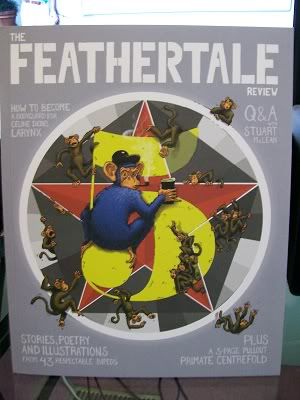
Then there was the fifth issue of
The Feathertale Review...
I know I don't really have too many big problems with books I review here, especially not magazines, that being said, I'll assume I picked this one up on a weak issue.
Maybe I had high expectations, but I thought a humour magazine with a cover that advertises stories about protecting Celine Dion's voice box, a Q&A with Stuart Mclean and a "3-Page Pullout Primate Centrefold" to be funny. I expected it to be thoroughly funny. I got my laughs, don't get me wrong (mainly at the stories that were mentioned on the cover, now that I think about it) but as a whole it seemed like they were trying real, real hard to meet their promises of being funny.
Humour is a personal thing, and I'll assume that this may not have been my kind of humour. I'll try again next time, and hope that I'm more impressed.

As a nice way to end off, here's a great art-focused magazine published through the University of Guelph,
Carousel issue 25 (Spring/Summer 2010).
During my perfunctory flip through of the magazine after noticing the cover by Toronto cartoonist/artist
Michael DeForge I noticed a great deal of things that I instantly enjoyed. Paintings/Illustrations, lots of them. Comics, a good deal of them. SHORT works/poems/interviews. Plus a great bare-bones layout that makes it real easy to read. Oh, and more Michael DeForge.
I can't say enough about this magazine, and for something that is put out through a University (not to mention one so close to me), this is amazing. And as a final point, I want to mention that this is the ideal length of a magazine in my opinion. Just under 70 pages, many of which are primarily images with little to no text to drown them out.
Mark Laliberte's art made it a bit of a struggle to read the written pieces on the opposite page, but that was a small, small price to pay for this. I'm extremely impressed.











